In this Article:
Gun nuts, hunters, competitive shooters, and people who are a mixture of all three are constantly looking at the wide selection of cartridges available and trying to determine which is more useful. All cartridges are going to have a specific niche in the shooting world where they excel compared to others, but it’s always a fun and informative exercise to put two cartridges up against one another. In this case, it’s the .243 vs the .308.
In this article, we will be taking a look at two very popular cartridges in the US and the world, the .243 Win and .308 Win. These rounds have been on the market for over 50 years, and there is no reason why they won’t continue to be a mainstay in small firearm ammunition.
We are going to make a lot of comparisons on these two cartridges. In the end, we are not going to try to make a claim for which is the best. It’s all relative in our eyes to the situation they are being used in is going to determine which is better suited.
We will take a look at several ballistic categories and performance specs important for hunting and general shooting and discuss the similarities and differences between the two. From there, we can discuss the applications for each cartridge and under which situations they will be better suited.
A Brief History
.308 Winchester
The .308 Winchester was introduced by Winchester in 1952. Though the predecessor, this cartridge is the civilian version of the 7.62×51 NATO round that saw brief use in Vietnam before being replaced, but it still has a niche in military and other tactical communities even today.
Where the .308 has gained a strong and loyal following is in the hunting community. This is a larger bullet with excellent range and stopping power. It’s a great medium to large game rifle and can be used for just about any large game animal in the world, barring a few.
Not only is the .308 a fantastic civilian hunting round, but it also displays enough speed, power, and distance to be adapted into police force sharpshooting units. That is a high recommendation for the use of this cartridge.
The .308 is extremely popular, and you can tell based on the sheer amount of ammunition and type of ammunition that is available. There are several bullet weights, powder charges, and bullet design can all impact the bullets flight and power characteristics.
.243 Winchester
The parent case of the .243 is the other cartridge of discussion in this article, the .308. There are some key differences between the two modern cases. The .243 is a necked down version of the .308 which allows it to take the smaller diameter bullet, the .243. Sometimes referred to as the little brother of the .308, which we are sure it doesn’t appreciate, it is important not to let that comparison influence how these two cartridges perform. As we will see, there might be some big differences between what the two siblings are good at.
Regardless, we will see that there are quite a few similarities between these two rounds which can be attributed to the .243 being a modification of the .308.
The .243 comes in a wide range of bullet sizes and makes it a pretty versatile gun in the hunting world for the type of game it can effectively be used against. It was initially a varmint hunting gun, but the arrival of larger grain bullets and more powerful charges providing more velocity allowed this round to be adapted to larger game such as deer. It pretty much limits out with deer regarding large game hunting as we will discuss in this article. The .243 Win also has a pretty rich history in the long range shooting community. And while newer and flashier rounds have come onto the scene, some of the top shooters in the world still load a .243 and they win with that cartridge consistently.
Specs
| .308 Winchester | .243 Winchester | |
|---|---|---|
| Parent Casing | 0.3 | .308 Win |
| Bullet Diameter | 0.308†| 0.243†|
| Neck Diameter | 0.3433†| 0.276†|
| Base Diameter | 0.4709†| 0.471†|
| Case Length | 2.015†| 2.045†|
| Overall Length | 2.8†| 2.7098†|
| Case Capacity | 56gr | 53-54.8gr |
| Max Pressure (SAMMI) | 62,000psi | 60,000psi |
By looking at the case and bullet dimensions, we can immediately begin to make assumptions about these two cartridges. Because the parent case of the .243 is the .308 Winchester, these cartridges have some similarities, but as we will see, there are also a lot of differences. The most noticeable difference is in the neck diameter where the .308 is much wider to fit the larger caliber bullet. We also see that the .308 can withstand higher pressures than the .243 Win which allows the .308 to run a little hotter. For the heavier bullets that the .308 uses, it’s going to need a little more force to get those bullets at the speed needed for proper terminal ballistics The .243 is also longer than the .308 and cannot handle as high an internal pressure as the .308 Win.
Besides those differences, these two cartridges have very similar case dimensions such as the base diameter, case length, overall length, and the case capacity. To see how these two cartridges stack up against each other we have chosen ten factory rounds, five for each cartridge type, and those are listed below.
And we are aware that there are a lot of other options that are on the market and there is a good chance that a round you use and has served you well might not be present. This list is not composed of rounds that we think are superior to all others. We chose these to get a nice, diverse selection of rounds with differences in several aspects within each cartridge type.
 .243 Winchester Super-X Power Point 100gr
.243 Winchester Super-X Power Point 100gr .243 Hornady Superformance Varmint V-Max 58gr
.243 Hornady Superformance Varmint V-Max 58gr .243 Remington Core-Lokt PSP 100gr
.243 Remington Core-Lokt PSP 100gr .243 Federal Vital-Shok Nosler Ballistic Tip 95gr
.243 Federal Vital-Shok Nosler Ballistic Tip 95gr .243 Nosler Varmageddon FB Tipped 55gr
.243 Nosler Varmageddon FB Tipped 55gr
 .308 Hornady BTHP Match 168gr
.308 Hornady BTHP Match 168gr .308 Winchester Super-X 180gr
.308 Winchester Super-X 180gr .308 Nosler Ballistic Tip 165gr
.308 Nosler Ballistic Tip 165gr .308 Federal Vital-Shok Ballistic Tip 150gr
.308 Federal Vital-Shok Ballistic Tip 150gr .308 Federal Gold Medal Sierra Matchking 175gr
.308 Federal Gold Medal Sierra Matchking 175gr
As you can see, we are only comparing a limited number of different rounds for each cartridge. While we are selecting a variety of rounds with a good range of bullet weights and designs, it’s only scratching the surface. There is a lot more to a good hunting and competition rounds, but with limited time and space, our selections for comparison will give you an excellent starting point and base of knowledge to dive even deeper into the discussion.
And because there is always the chance that using such a small sample size might not give us a fair representation of the entire set of options that are out there, we have compiled the data for more rounds. At the end of each section, we will present the averages for the larger sample size and discuss the results briefly. For the sake of clarity, we are not going to graph all of that data, but it should show that the selections we have made is a fair representation. And if it doesn’t, we will discuss why. All of the rounds we have compiled are listed at the end of the article.
It’s also important to note that these are all factory rounds and they are not going to have the performance of hot hand loaded rounds that you might come across on other sites or forums. We chose to stick only to factory loads because the majority of people do not handload and that information would not be useful to a lot of people.
Finally, before you jump into the comparisons, we want to make clear where this data is coming from.
The majority of the data is available from the manufacturer, and where that was not available, we relied on ballistic calculators from trusted sources. Where ballistic calculators are used we kept as many variables the same between rounds of the same cartridge. Where calculations are made, we will be sure to make clear our variables.
When it comes to this type of data, there is no concern with comparing cartridges, but you should be aware that these numbers can change when being fired from your rifle. Each rifle tends to have its own small differences in its profile, and this means some small differences in the ballistic output. As far as comparing the two cartridges go, computer generated data has its advantages in that these small differences are negated.
So, with all of that out of the way, let’s get into the fun stuff.
Recoil
This section is as clear of a decision as any other category we will discuss on the .243 vs .308. When most of us think of recoil, we think of the actual kick that is felt when the gun is fired. A lot of factors go into the actual “felt recoil” that we can’t put numbers on for comparison. Instead, we are going to look at the actual energy(ft.lbs) that is created when the power is ignited.
There are several factors that influence the recoil energy. When the data was calculated we used the muzzle velocity for each round, the bullet weight, the gun weight, and the powder charge. We kept the gun weight constant at 7lbs and used the average for several popular powder brands provided by Nosler load data for each cartridge. So while the numbers we present might fluctuate depending on the actual powder charge used by the manufacturer (not provided) or what your rifle weighs, the general trends are safe to draw conclusions from.
So, before we look at the ten rounds, let’s take a general look at the recoil energy generated by the two cartridges (Graph 1).
There is no debate on this category when comparing the .243 and .308 cartridges. The .308 kicks like a mule compared to the .243. With nine ft.lbs of difference between the two, even an experienced shooter is going to feel the difference between these two cartridges.
Of course, the energy generated is going to vary from round to round even within the same cartridge type.
In this graph, we take a look at our ten rounds and see how they compare and if the same trend continues from what we saw in the previous graph. (Graph 2).
Again, you can see that there is some deviation between the rounds of the same cartridge types. Also, keep in mind that some of these rounds might have less or more powder when used in reality, so the recoil energy may vary a little. Regardless, you can easily visualize the greater recoil energy that is produced by the .308 rounds on a consistent basis. All of the .308 rounds are generating more than 20ft.lbs of energy which is considered enough to influence the shot if you are not experienced with the round. On the other hand, the .243 rounds come in between 8 and 12ft.lbs of energy.
The above numbers indicate quite a significant difference between these two cartridges. And while we are confident that this result is indicative of how much recoil energy will be produced by any selection of factory loads available, we still want to look at the recoil data from our larger data set. You will find the data in the table below and note that the recoil data was generated using the same variables that we discussed earlier.
Average Recoil (ft.lb)
| .308 Winchester | .243 Winchester |
|---|---|
| 22.15 | 11.25 |
So when we increase the amount of samples that we have, we are still seeing the same disparity between the two cartridges. On average, the .308 Winchester is producing right around eleven more ft.lbs of force than the .243 Win rounds. And there is no overlap between these two cartridges. Any factory load you get for the .308 Win is going to produce more recoil than a .243 Win round. Now, the numbers might be a little closer depending on your rifle, but this trend is not surprising given what we know just from the cartridge specs alone.
We also have to be careful about making claims about performance just from the recoil. While the .308 Win produces more recoil, it’s a good indicator that there are going to be other differences between these two cartridges and more recoil might just be something you have to deal with if you want the other performance specs of the .308.
Ballistics
In the ballistics section, we will focus on the differences in velocity, ballistic coefficients, and trajectory. With this information, we can begin teasing apart where these cartridges would be better suited.
Ballistics is an important concept for anyone shooting a rifle, regardless of the application, but they can also be complicated by a lot of factors influencing each performance category. As we go through these various categories, keep in mind that they all play off of one another and all influence the performance and profile of each round. We look and compare each individually for the sake of simplicity, but all factor into the performance of the bullet and the cartridge as a whole.
Velocity
It’s not as simple as using higher burning powders as these cartridges can only hold so much and take so much pressure, and there is a fine line you walk with a hot round. If paired with the wrong twist rate, the bullet is going to be unstable in the air. For factory loads, you often don’t have to worry about this concept.
There are several reasons to look at the bullet velocity from the muzzle as it moves downrange. The velocity of the bullet is going to play a major role in the trajectory, which in turn, is going to determine the number of adjustments needed to make when taking shots at extended ranges. Velocity is also important in the terminal ballistics of a round as it influences the bullet’s energy as well as how the bullet will expand on impact.
We compiled the velocities of the ten rounds from the manufacture and have graphed them here (Graph 3).
We are looking at the velocity (ft.sec) from the muzzle out to 500 yards in 100-yard increments.
There are several interesting talking points we can harp on from this graph. The first is that the .243 seems to have higher velocities from the muzzle out to the 500-yard mark. The averages all support this though the .308 closes the difference as the rounds move downrange. One of the biggest reasons for this is how quickly the 55gr .243 rounds bleed off velocity. They come out with nearly 4,000ft.sec velocity and they maintain a distinct advantage until the 500-yard mark where all of the rounds begin to group much more tightly.
There is some overlap in velocities between the two cartridges as they reach the 200-yard mark and beyond as it appears that the .243 rounds bleed of velocity at a higher rate than the .308 rounds. All of these rounds maintain supersonic speeds out to 500 rounds and probably will for another several hundred yards.
Let’s take a look at the larger sample set and see if we can get a more definitive look at how these two cartridges compare in their bullet velocities.
Average Velocity (ft/s)
| Yards | .308 Winchester | .243 Winchester |
|---|---|---|
| Muzzle | 2733 | 3198.7 |
| 100 | 2521.5 | 2897.19 |
| 200 | 2320 | 2626.3 |
| 300 | 2182 | 2355 |
| 400 | 1946.5 | 2061.7 |
| 500 | 1775 | 1891.9 |
We again see that the .243 Win rounds come out of the muzzle with significantly more velocity than the .308 Win rounds with almost 500 fps difference. And like the small sample size, we also see that the .243 rounds bleed velocity at a higher rate than the .308 Win rounds where there is only a little over 100fps difference between the two at the 500 yard mark. And if you are thinking that extra light .243 rounds (under 60gr) are skewing the data, the average muzzle velocity with those two rounds removed is 3140fps and the 500 yard average is 1900fps. So, they do influence the average, but not as much as you probably think. We were curious about this as well and had to go back in and double check.
Average Supersonic Limit (Yards)
| .308 Winchester | .243 Winchester |
|---|---|
| 1023.7 | 957.5 |
Since we are looking at two cartridges that definitely have the potential for long range shooting, we want to look at what the average cut off is for these cartridges where they drop below supersonic speeds. For hunting purposes, this shouldn’t have as much an impact on your decision making since responsible hunters are not taking shots at this distance with these cartridges.
Marksmen are concerned with supersonic limits because once bullets fall below this speed, they start to become a lot less stable which makes adjusting for shots more difficult. When we look at these two cartridges, there is some about 70 yards difference in the average limit. There are .243 rounds that maintain supersonic speed through the 1,000 yard mark and there are .308 rounds that fall below supersonic speeds closer to the 700 yard mark. There is quite a wide range for both of these cartridges.
We also have to weigh the impact the light .243 varmint rounds are having on this average as we did with the velocity. While they are very fast rounds, we saw that they bled velocity quickly. We still include them because this is a comparison of two cartridges and not of just individual rounds. The varmint rounds are not throwing too big a wrench into these numbers though as we only included two of these lighter rounds (under 60gr) into the data set. And if we take them out, the average only increased to 963 yards.
So these rounds are not influencing these averages any more than a lot of the other rounds do. Still, because they are different from other .243 Win rounds, we will keep an eye on them as we move into other categories.
Ballistic Coefficient
The BC is simply a rating that is derived from an equation that uses multiple cartridge/bullet variables. What this number tells you is how well the bullet resists wind drag and wind drift throughout its flight path and gives you an idea of how well a bullet will be able to cut through air and wind resistance. The higher the ballistic coefficient, the less drag, and influence this resistance will have on the traveling bullet. For shots taken at extended ranges, a higher BC often means fewer adjustments will have to be made to get the bullet on target. The ballistic coefficient is not everything when it comes to having a true flying bullet. While we think it has a large role in making difficult shots easier, don’t make the error of thinking that if a bullet has a high BC, it is going to do all the work for you or replace experience and skill.
Often, the ballistic coefficient is given more attention with long range shooters, but we think it can be important for hunters as well. While hunters might not be taking shots at distances where they need to be worried about the bullets wind and drag resistance, it can’t hurt to know as much about your cartridge as possible.
We have compiled the ballistic coefficients for all ten of the selected rounds and graphed them here (Graph 4).
When we look at the BCs of these two rounds we see that the .308 round, at least from this selection of rounds, has higher ballistic coefficients. There are .308 rounds with lower BCs that look more like the .243 rounds, but there are also rounds with close to double the BCs of some .243 rounds. Generally, increased mass of the bullet increases its ballistic coefficient, given their body design and caliber are similar, and we see that the .308 cartridges uses heavier bullets than the .243 Win cartridge.
So there is some variability within each cartridge type, but generally, .308 rounds are going to have higher BCs.
Just to be sure, let’s take a look at the averages when we add more sample rounds.
Average Ballistic Coefficient
| .308 Winchester | .243 Winchester |
|---|---|
| 0.434 | 0.343 |
We mentioned earlier that there are rounds where the ballistic coefficient is a bit closer between these cartridges, but overall, the averages give an advantage to the .308 Win rounds. Any data set that you work with is going to have outliers and the .243 Win rounds do have several of those. especially the very light varmint rounds which bring down the .243 Win BC average slightly. Even when we take out those rounds, the average BC for the .243 Win only increases to 0.35 which is still enough difference between the .308 average to warrant discussion later.
Trajectory
It doesn’t matter what you are using a rifle for or what cartridge you are using. The trajectory of the bullet is often one of the most discussed and scrutinized ballistic components. As bullets move downrange, they have a flight path of a parabola. As the bullets lose velocity and as outside influences act on the bullet, it loses altitude. For a cartridge comparison such as the .243 vs .308, potential users want to see which has a flatter trajectory, meaning it shows less bullet drop.
Before we look at specific ranges with the short and long-range trajectory, we want to step back and just look at two rounds, one from each cartridge type, that are similar in bullet weight, BC, and bullet design. Hopefully, this begins to give us an uncluttered look at how the trajectories of these two cartridges compare (Graph 5).
Just because of the nature of these two cartridges, there is some difference between the bullet weights of these two rounds that we have no control over.
We see that there is less than an inch of difference in bullet drop between these two rounds out to the 350-yard mark. From this point, the gap does widen slightly with the .243 round continuing to show a slightly less pronounced drop in trajectory than the .308 round. Even so, the biggest difference in trajectory is not until the 500-yard mark where we re only looking at five inches of difference, at the most.
While the .308 is using much heavier bullets than the .243, they are also using more powder to propel them downrange. So even though the light .243 rounds has a slightly flatter trajectory than the .308, it’s not as pronounced as one might think.
Let’s increase the number of rounds we are comparing and see if this trend continues.
Short Range Trajectory
Both of these cartridges are very popular whitetail cartridges, among other medium sized game, and in these scenarios, the majority of shots are coming at ranges up to 300 yards. Because of this, we want to compare the short-range trajectories of our selected ten rounds.
We compiled data from the manufacturer when available and also from ballistic calculators. To generate data from a ballistic calculator we used the rounds BC, muzzle velocity, and bullet weight (Graph 6).
With the short range trajectory, we do see some patterns regarding cartridge type. The .243 rounds have the flattest performing rounds with the 55 and 58gr bullets. Even barring those two rounds, all of the .243 rounds show a flatter trajectory than the .308 rounds though the difference is minimal at the 200-yard mark. At this point, there is less than two inches difference between the averages of the two cartridges, and if we omitted the two light .243 rounds, there is less than one inch. Regardless of the difference, every round shows less than 5 inches of bullet drop at the 200-yard mark.
The same trend continues at the 300-yard mark. We do see the rounds begin to distance themselves from each other a bit more. Like at the 200-yard mark, the lightweight .243 rounds are nearly five inches flatter than the next closest round. Even the steeper dropping .243 rounds are 2-3 inches flatter than all but one of the .308 rounds. At this point, the averages for both cartridges is 9.72 inches for the .243 and 14.68 for the .308.
Let’s take a look at the short range numbers when we add more rounds, especially with the .243 Win rounds with heavier bullet weights.
Average Bullet Drop (Inches) at Short Range
| Yards | .308 Winchester | .243 Winchester |
|---|---|---|
| 50 | -0.125 | -0.235 |
| 100 | 0 | 0 |
| 200 | -4 | -2.62 |
| 300 | -14.5 | -11.19 |
| 400 | -32.8 | -24.78 |
We still see the same trend here, with the .243 rounds showing several inches less bullet drop than the .308 Win rounds. There is not a huge difference between the two at the 200 and 300 yard mark, and we are still only looking at about 8 inches of difference between the two when we go out further at 400 yards, which is pretty impressive given the much heavier bullet weights of the .308 Win rounds. Of course, you’re also dealing with a lot more recoil, as we saw earlier. There are always trade offs when trying to decide between two cartridges or even just two different rounds.
These are the ranges that are most often encountered in hunting scenarios. And we realize that most of you are already aware of what we are about to say, but trajectory is far from the only performance spec that needs to be considered when thinking about a cartridge you are wanting to use. So don’t close out the article yet thinking the .243 Win is what you need. We’ll get into some other important performance factors for hunting shortly.
Long Range Trajectory
Although neither of these rounds is regarded as a premier long-range option in modern shooting, they remain popular choices for many shooters. Therefore, we’ll examine their long-range trajectories.
Data for this analysis was gathered similarly to the short-range trajectory, but the graph extends to 500 yards (see Graph 7).
Overall, we see a similar trend as we did with the short range trajectory. Besides the two lightweight .243 rounds, we see tight groupings of all the other rounds at the 300 and 400-yard marks.
At the 500-yard mark, the .243 rounds exhibit a clear advantage in trajectory. Although some .308 rounds cluster more closely with the steeper .243 rounds, the overall difference is significant. The average bullet drop for the .243 is 38 inches, compared to 50 inches for the .308.
Next, we’ll examine the long-range averages for these cartridges with a larger sample of rounds and extend our comparison to 700 and 1000 yards to confirm if this trend continues.
Average Bullet Drop (Inches) at Long Range
| Yards | .308 Winchester | .243 Winchester |
|---|---|---|
| 100 | 2 | 1.43 |
| 200 | 0 | 0 |
| 300 | -8.5 | -6.4 |
| 400 | -24.7 | -19.3 |
| 500 | -50.3 | -39.86 |
| 700 | -137.6 | -116.7 |
| 1000 | -401.6 | -373 |
When we look at the data for the larger data set, we do see the .243 Win cartridge has a flatter trajectory throughout the entire range. We also see that as the distance increases, the difference between the two cartridges increases. Compared to the ranges that we used with the smaller sample, the difference between the two rounds is not large but still apparent. Where we start to see major differences in the performance of these cartridge is at the 700 yard mark and beyond. At these two markers, we see right around 20 to 30 inches separating the two cartridges. (20.9 at 700 yards and 28.6 at 1000 yards). And while the .308 trajectory is still impressive given that bullets sometimes twice the weight or more than the .243 Win rounds, this is a distinct advantage for the .243 Win in long range trajectory.
And while the .243 might appear to be a clear-cut winner there is more that you have to consider depending on what you are doing. Especially if it is hunting, where stopping power is as critical and is the subject of our next section.
Stopping Power
These two cartridges are not typically used for home defense, so our focus will be on their effectiveness for hunting. Though the .308 does have some tactical applications, it’s not our primary focus here, especially given that we’re also comparing it with the .243 Win.
For hunting, it’s crucial to have confidence that a bullet will deliver enough force to ensure a clean and efficient harvest. We will evaluate the stopping power of these cartridges using three key metrics: kinetic energy, sectional density, and bullet momentum. These metrics help gauge how well a round can penetrate and effectively bring down game.
While these are important factors in assessing stopping power, they are not the only ones. Bullet design, which affects penetration and wound characteristics, and shot placement, the most critical factor for effectiveness, are also vital. However, these elements are not covered in this comparison.
Stopping power results from a combination of factors, so we don’t claim that any single metric is the definitive measure of a round’s effectiveness. Each metric provides valuable insight into different aspects of stopping power.
Energy
The force or energy (ft.lbs) that a bullet carries along its trajectory is transferred to the target upon impact, which can inflict significant damage to the surrounding tissue and organs. This makes it crucial to evaluate this aspect of stopping power. General guidelines often suggest that about 1,000 ft.lbs of energy is ideal for taking down medium-sized game, though this requirement increases for larger animals.
Both the .243 Win and .308 Win are popular choices for hunting whitetail and similar-sized game, though the .308 Win might have additional uses that will be discussed later. While energy is a key factor, shot placement is equally important, if not more so. Additionally, the bullet’s expansion plays a vital role, as it ensures that the maximum energy is delivered to the target.
Let’s review the kinetic energy data for our ten selected rounds to compare how these two cartridges stack up (Graph 8).
The differences in bullet energy between these two rounds is obvious. Rounds of each cartridges cluster tightly together through the 500 yards with the .308 showing significantly more bullet energy than the .243.
From the muzzle, we are looking at nearly a 1,000ft.lbs difference in the averages of the two cartridges. The difference shrinks as the rounds move downrange but the advantage still clearly belongs to the .308 rounds. And we would expect this trend given the similarities in velocity between the rounds, barring the two lightweight .243 rounds, and the increased bullet weights of the .308 rounds.
At the muzzle, the .308 rounds have bullet energies above 2,500ft.lbs, and all remain between 1,000 and 1,400ft.lbs at the 500-yard mark. The .243 rounds all have muzzle energies between 1,700 and 2,000ft.lbs at the muzzle but drop below the 1,000ft.lb mark by 400 yards. This information is going to be useful when we discuss the applications of these rounds.
With such a disparity between these two cartridges, let’s take a look at more rounds and see if the gap widens or closes.
Average Bullet Kinetic Energy (ft.lbs)
| Yards | .308 Winchester | .243 Winchester |
|---|---|---|
| 0 | 2723 | 1936.6 |
| 100 | 2319.9 | 1595.45 |
| 200 | 1966.5 | 1302.7 |
| 300 | 1657.9 | 1062.3 |
| 400 | 1389.7 | 858.25 |
| 500 | 1109.5 | 692.15 |
When we expand our sample size, we still see that the .308 Win rounds carry quite a bit more kinetic energy downrange than the .243 Win rounds, though we do see the difference shrink by a few hundred ft.lbs than what we saw in the graph above. There is still a large difference though and it is substantial enough to take note of and take into account when thinking about which applications these cartridges would be better suited for.
We do see that the .308 Win rounds still carry over 1,000ft.lbs through the 500 yard mark while the .243 Win rounds begin falling below this threshold at the 300 yard mark. And again, this might or might not matter to you based on the type of hunting you have in mind.
Penetration (Sectional Density)
To evaluate how effectively these cartridges can penetrate a target, we examine the sectional densities (SD) of the rounds we’ve been comparing. It’s important to remember that not all shooting or hunting scenarios require extreme penetration. This reinforces the idea that neither cartridge is definitively superior; each has strengths suited to different applications.
Sectional density is calculated based on a bullet’s weight and diameter. A higher SD generally indicates greater potential for penetration. However, SD is just one factor; velocity and bullet type also play crucial roles in determining penetration, which we will explore further in the application section. Bullet momentum, closely related to sectional density, also influences penetration.
To illustrate how sectional density affects penetration, consider this example: Bullet A weighs 100 grains and has a diameter of .300 inches, while Bullet B weighs the same but has a diameter of .200 inches. Assuming all other factors are equal, Bullet B, with its higher SD, should penetrate more deeply. This is because, despite having the same mass, Bullet B’s force is concentrated on a smaller area, akin to using a hammer to drive in a nail versus a broad tool like a 2×4. This concept underpins sectional density.
When we review the SDs of the ten rounds (Graph 9), calculated with an SD calculator, we see noticeable differences between the two cartridges.
Firstly, there are notable variations within the .243 rounds themselves. The lighter .243 rounds exhibit a significantly lower sectional density compared to the heavier .243 rounds.
When we compare the heavier .243 rounds to the .308 rounds, the differences in sectional density become less pronounced. Although all .308 rounds maintain higher sectional densities, the difference is relatively small, ranging from just 1 to 3 hundredths.
The greater sectional density of the .308 rounds is primarily due to their larger diameter, even though the .243 rounds are lighter. This detail will help us analyze the suitability of these cartridges for various hunting applications in the upcoming sections.
Average Sectional Density
| .308 Winchester | .243 Winchester |
|---|---|
| 0.248 | 0.209 |
When we look at the numbers for the larger data set, we see the same trend that we just observed for the smaller data set. While the .243 Win rounds have an average that is only about 3 one hundredths behind the .308 Win rounds, this is quite a bit for sectional density. And while there are also several .243 rounds that have a sectional density closer to the .308 average and there are a couple .308 rounds that do not have as high a sectional density as some .243 Win rounds, you are generally going to have more options for high sectional densities with the .308 Win.
You might be getting tired of hearing this, but it’s crucial to remember that we haven’t factored in bullet design. Even with high sectional density, a bullet that disintegrates upon impact may not penetrate as deeply as a round with lower sectional density but a bonded jacket. The depth and complexity of this topic offer endless opportunities for learning and exploration.
Penetration (Momentum)
The final metric we’ll examine for stopping power is bullet momentum. This measures how effectively a bullet can overcome resistance. From a hunting perspective, this translates to how well a bullet can penetrate a target. Momentum is closely related to sectional density because it reflects the bullet’s ability to resist external forces. Generally, higher sectional densities indicate that the bullet can overcome more resistance due to its increased force.
In essence, higher momentum means the bullet can maintain its forward motion despite encountering resistance. Momentum, therefore, reflects an object’s capacity to keep moving when faced with opposition.
We calculated the momentum for the selected rounds and graphed the results from the muzzle out to 500 yards (Graph 10).
Like the kinetic energy, we see a significant difference in the momentum between these two cartridges. And that seems to be a trend between these two cartridges when looking at how they compare in the components of stopping power. And that’s not to say the .243 Win is not a lethal round for game, but the numbers show that the .308 Win is much better suited when tackling larger game and the majority of hunters would agree with us.
We definitely see from this graph that these two cartridges look to behave differently. We see that the rounds of each specific cartridge group pretty tightly together though the .243 rounds seem to split into two groups.
As you can probably guess just by looking at the chart, the two rounds with the lowest bullet momentum are the 55 and 58gr rounds. Even with the heavier .243 Win rounds, there is still a very significant gap between them and the .308 Win round with the lowest momentum.
We see that all of the .308 Win rounds leave the muzzle with over 60lbs/ft.s of momentum, several closer to 70, while the .243 rounds, besides the 55 and 58gr rounds, hover near the 40lbs/ft.s mark. This difference between the cartridges remains the same as the rounds move downrange though the amount of difference between the two cartridges does drop to only 17lbs/ft.s when we don’t include the 55 and 58gr rounds.
Let’s look at the bullet momentum averages when more rounds are added into the equation.
Average Bullet Momentum (lb/ft.s)
| Yards | .308 Winchester | .243 Winchester |
|---|---|---|
| Muzzle | 64.1 | 38.9 |
| 100 | 59.1 | 35.4 |
| 200 | 54.4 | 31.9 |
| 300 | 49.9 | 29.6 |
| 400 | 45.7 | 26.3 |
| 500 | 41.7 | 24.5 |
As with the smaller sample size, the .308 Win rounds produce nearly 25 lbs/ft more momentum at the muzzle and about 17 lbs/ft more at 500 yards. Although the .308 Win rounds do lose momentum at a higher rate compared to the .243 Win rounds, they still retain significantly more momentum at distances where most hunting shots are made.
Special Offer: Join our private community and get exclusive gun deals, handpicked gear recommendations and updates on law changes, every day!
Join our private community
Accuracy
When comparing the .243 and .308 cartridges, many hunters and marksmen seek to understand how each performs in terms of accuracy. In reality, accuracy is more often tied to factors such as the firearm, optics, and the shooter’s skill rather than the cartridge alone. However, ballistics can still play a role, especially for those who are proficient in their shooting.
At distances within 200 yards, both cartridges can deliver impressive accuracy due to their favorable trajectories. As ranges extend, the .243 exhibits a slight edge over the .308, showing less bullet drop. This advantage is particularly notable with lightweight .243 rounds, but heavier .308 rounds can offer similar performance for applications requiring more robust rounds.
The .308 generally benefits from higher ballistic coefficients, which may help mitigate the effects of environmental factors like wind, despite its more pronounced bullet drop compared to the .243. The heavier .308 bullets, with their higher BCs, can offer better performance in challenging conditions.
Recoil is another consideration, with the .308 producing nearly double the recoil energy of some .243 rounds. This increased recoil can affect accuracy, particularly for less experienced shooters, potentially leading to less consistent shot placement.
Additionally, the .308 can accommodate larger bullet sizes, and the rifle’s twist rate is crucial for ensuring bullet stability. A mismatch between bullet weight and twist rate can negatively impact accuracy. Similarly, while the .243 also requires proper twist rate alignment, handloading issues can sometimes affect performance, though this wasn’t covered in detail in this article.
Ultimately, the differences in accuracy between the cartridges, considering their cases and bullet designs, are minimal. The key factors will be the shooter’s proficiency and the specific shooting conditions encountered.
Price and Availability
Both the .243 and .308 cartridges are widely available on the market. Most major retailers will stock both types and offer a range of options for each. Availability can vary based on your location, but the internet has significantly eased the process of finding specific rounds for either cartridge. However, keep in mind that less common or specialized rounds might come at a higher price.
| Ammunition | Price (20 Rounds) |
|---|---|
| 308 Hornady BTHP Match 168gr | $22.89 |
| 308 Winchester Super-X 180gr | $21.99 |
| 308 Nosler Ballistic Tip 165gr | $30.99 |
| 308 Federal Vital-Shok Ballistic Tip 150gr | $31.79 |
| 308 Federal Gold Medal Sierra Matchking 175gr | $25.99 |
| 243 Winchester Super-X Power Point 100gr | $17.99 |
| 243 Hornady Superformance Varmint V-Max 58gr | $22.99 |
| 243 Remington Core-Lokt PSP 100gr | $22.99 |
| 243 Federal Vital-Shok Nosler Ballistic Tip 95gr | $29.99 |
| 243 Nosler Varmageddon FB Tipped 55gr | $31.99 |
Regarding price, the .243 round is on average cheaper than the .308. It all depends on the quality of the cartridge as well. There are cheaper versions of each cartridge available in bulk while high-end rounds are both going to be pretty expensive regardless of the cartridge. For a 20 round box of .308 rounds that are reliable enough to be used in the field, you’re looking at around $35 on average. For the .243, you’re looking more at an average price of $30 for a box of 20 rounds. Like the .308, a box of .243 cartridges can vary from $20 to $50 bucks.
Overall, the price of these cartridges is not very different. Not enough to choose one of the other based solely on price in our eyes.
Applications
Now that we have a comprehensive comparison of the .243 vs. .308, let’s explore scenarios where one cartridge might be preferred over the other.
The .308 is frequently praised as an excellent choice for short-range hunting of whitetail and other larger game. Its strength lies in the substantial energy it delivers and its impressive penetration capability. This high momentum ensures that even if your shot encounters some brush, it’s more likely to penetrate and reach the target effectively. Moreover, while the .308 is renowned for its short-range performance, it’s also suitable for shots extending beyond 300 yards. Though you’ll need to account for bullet drop with heavier rounds, opting for lighter bullets or higher-pressure loads can help mitigate this. With its formidable stopping power, the .308 is versatile enough to handle large game across various distances. However, its recoil is notably stronger than that of the .243, which may be challenging for less experienced shooters.
On the other hand, the .243 excels in several hunting roles due to its light weight and high velocity. It is particularly effective for varmint and predator hunting. By increasing bullet weight, the .243 can also serve as a competent whitetail cartridge, offering a performance comparable to the .308 in terms of velocity and penetration. Although it lacks the .308’s bullet momentum, this is less critical for the typical game the .243 is used for. Whitetail deer, for instance, do not possess the dense hide or bone structure that demands high momentum. The .243 does have a good range but loses energy more rapidly, which can be a disadvantage for taking larger game at long distances unless the shot is perfectly placed.
In terms of cost, .243 ammunition is generally less expensive than .308. Its flat trajectory and high speeds make it a fun and cost-effective choice for range shooting. Additionally, the minimal recoil makes the .243 an excellent option for introducing new or younger shooters to the sport.
When considering long-range shooting, both cartridges have their strengths and weaknesses. Focusing strictly on factory loads and not handloading, the .243 offers a flatter trajectory but is more susceptible to wind due to its lighter bullets. Conversely, the .308, with its heavier bullets and generally better ballistic coefficients, performs better in windy conditions and retains more stability over long distances.
For those with considerable shooting experience, the recoil of the .308 is manageable with the right equipment and shooting techniques. However, for beginners or younger shooters, the recoil might be a concern. Ultimately, getting hands-on experience with both cartridges will help determine which one feels right for you in terms of recoil and overall shooting comfort.
Best Rounds
Before we conclude this article, let’s review the ten rounds we’ve been comparing and highlight a few choices from each cartridge that we believe are particularly well-suited for specific tasks. These recommendations are based on our analysis and personal opinions; many other rounds, not included on our list, could also perform excellently. Ultimately, the best round is the one you trust and have consistently found success with.
Top Hunting Round
For the .308 Win, we recommend the Nosler Ballistic Tip 165gr. This round stands out for medium to larger game, boasting the highest bullet energy of our selected .308 options, with 1,300 ft-lbs at the 500-yard mark. This level of energy is adequate for taking down larger game at that distance, provided the shot is well-placed. Its superior long-range trajectory makes it effective for shots up to 300 yards and even manageable at 400 yards.
For the .243, we favor the Federal Vital-Shok Nosler Ballistic Tip 95gr. This cartridge excels for deer-sized game, offering an impressive trajectory with only 3 inches of bullet drop at 200 yards. It maintains sufficient velocity for effective penetration and expansion, and delivers ample stopping power out to 300 yards, making it a top choice for .243 hunting applications at this weight.
Top Range Round
For the top .308 Win range round, we recommend the 168gr Hornady BTHP Match. This round is cost-effective, making it ideal for extended range sessions. It features an excellent ballistic coefficient (.45), and combined with its velocity and long-range trajectory, it excels in precision shooting.
For a .243 round to take to the range, we suggest the 58gr Hornady Superformance Varmint V-Max. This round offers high velocities and exceptional trajectory, though it does lose speed rapidly at distances beyond 500 yards. It has minimal recoil, making it enjoyable for extended shooting sessions with little fatigue. Although it may not perform as well at extreme ranges due to drag and wind drift, it remains affordable and is a lot of fun for range practice.
Conclusion
When comparing the .243 and .308 cartridges, each has distinct advantages depending on the situation and your personal preferences. Both cartridges are excellent choices, widely available, and versatile across various shooting scenarios. We hope this article has offered a comprehensive comparison, giving you a solid foundation to make an informed decision based on your specific needs and preferences.





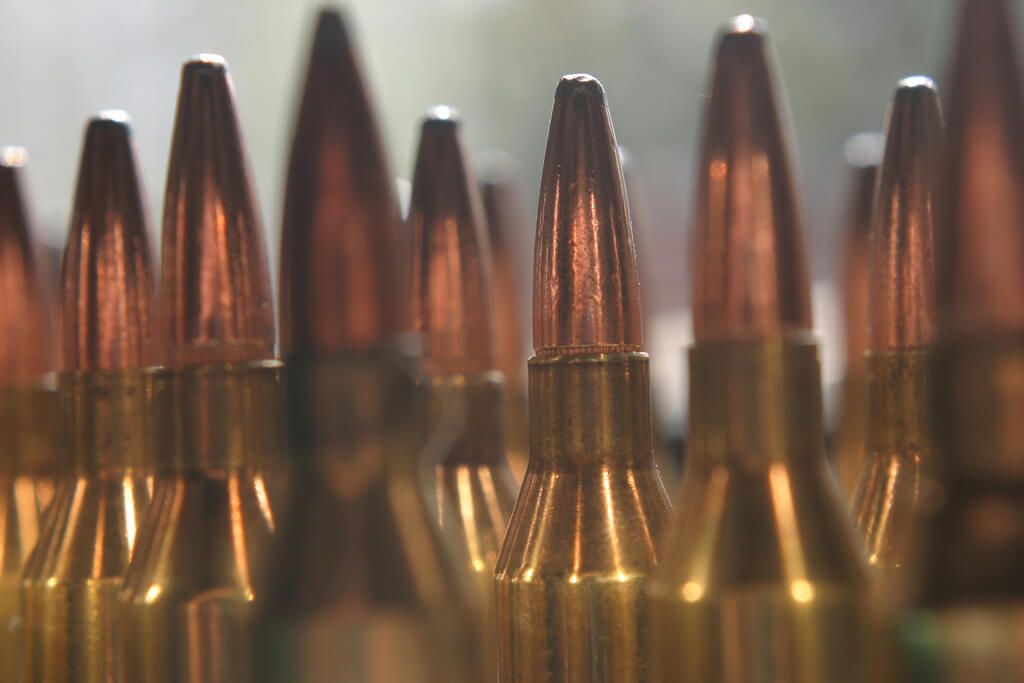
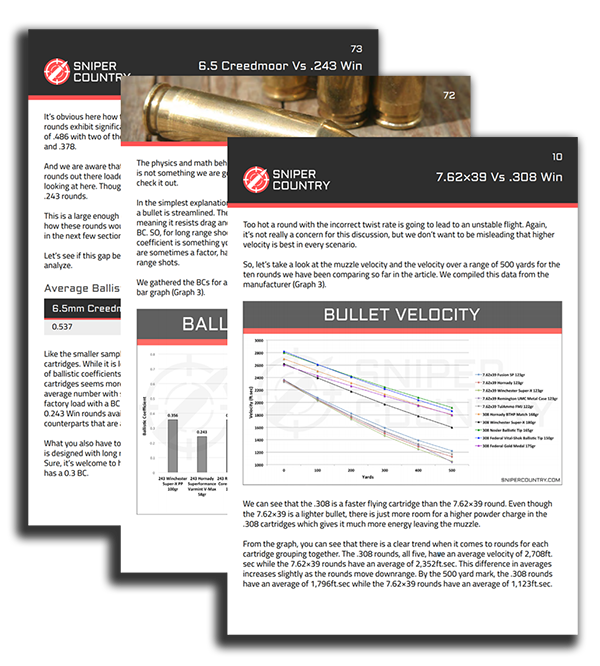

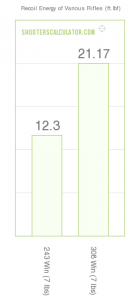
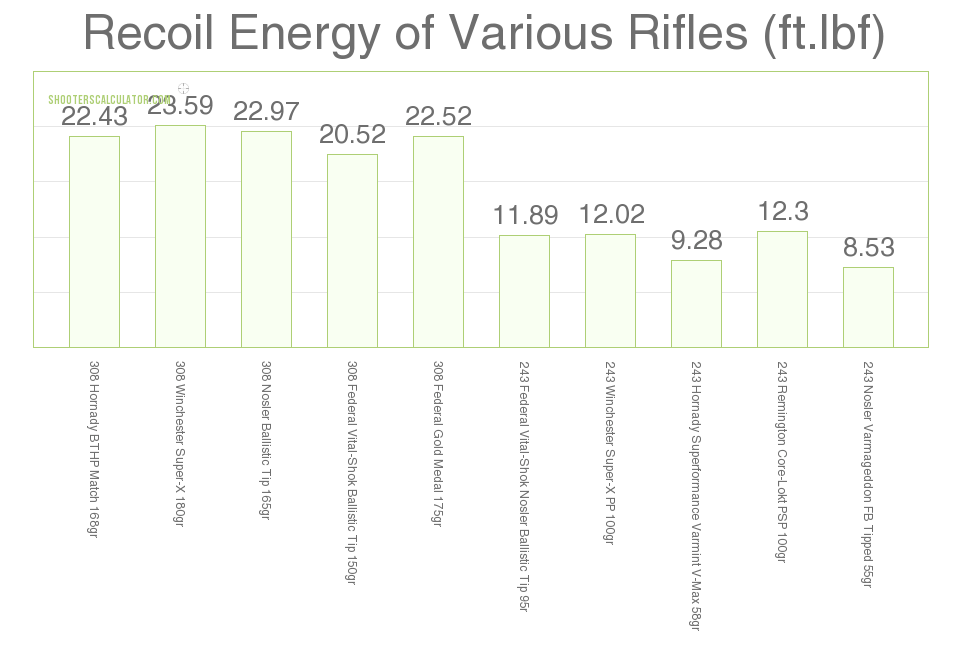
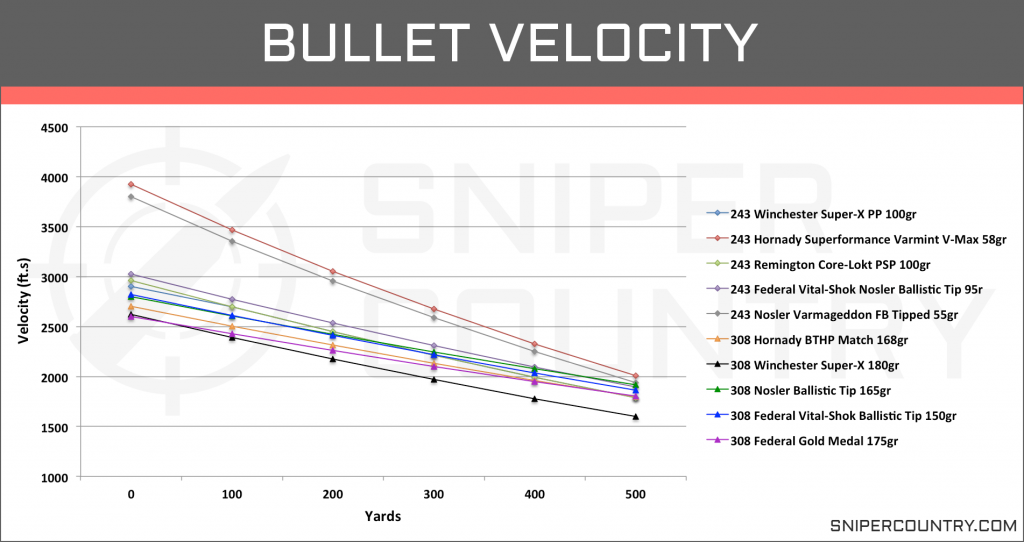
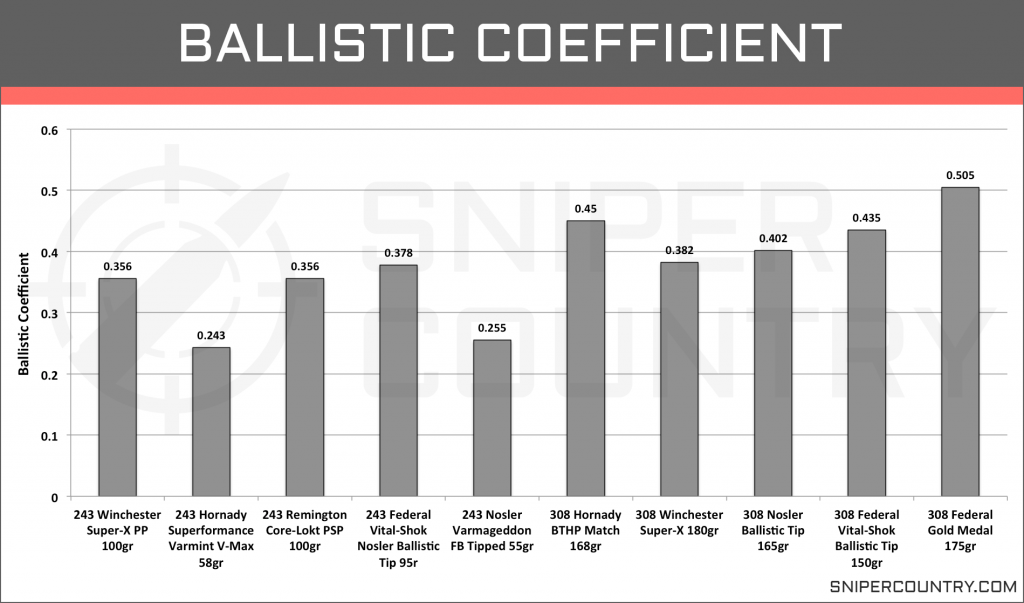
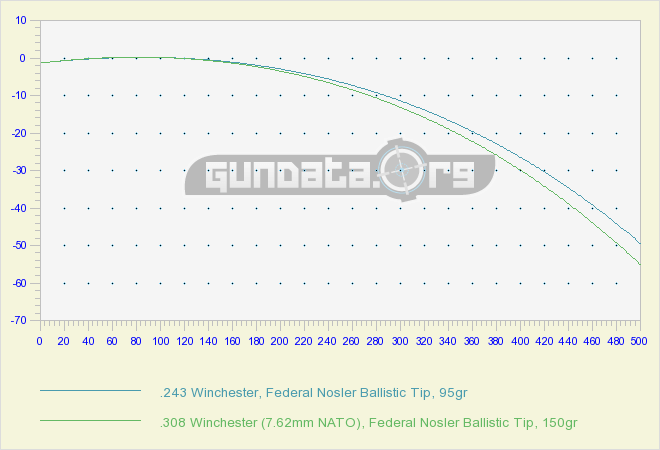
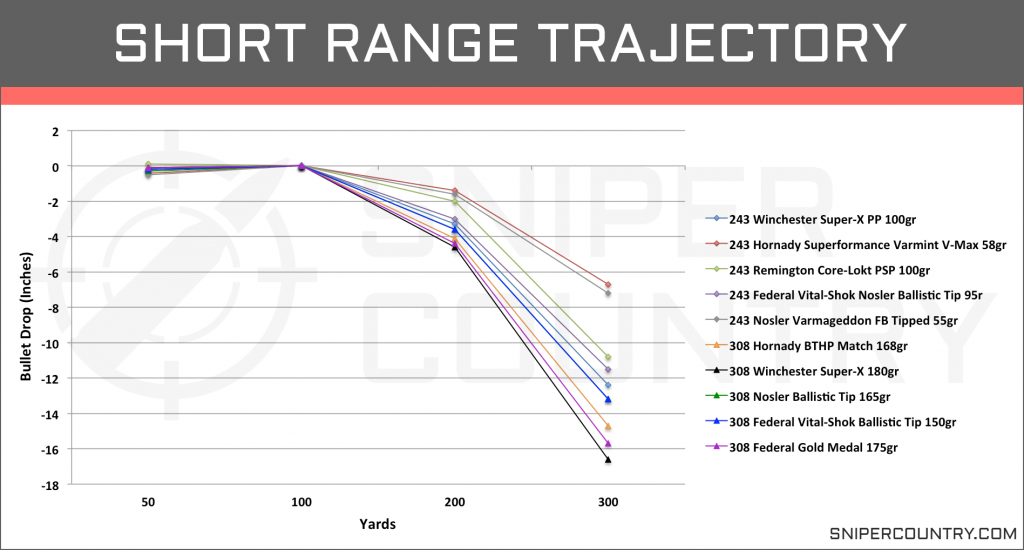
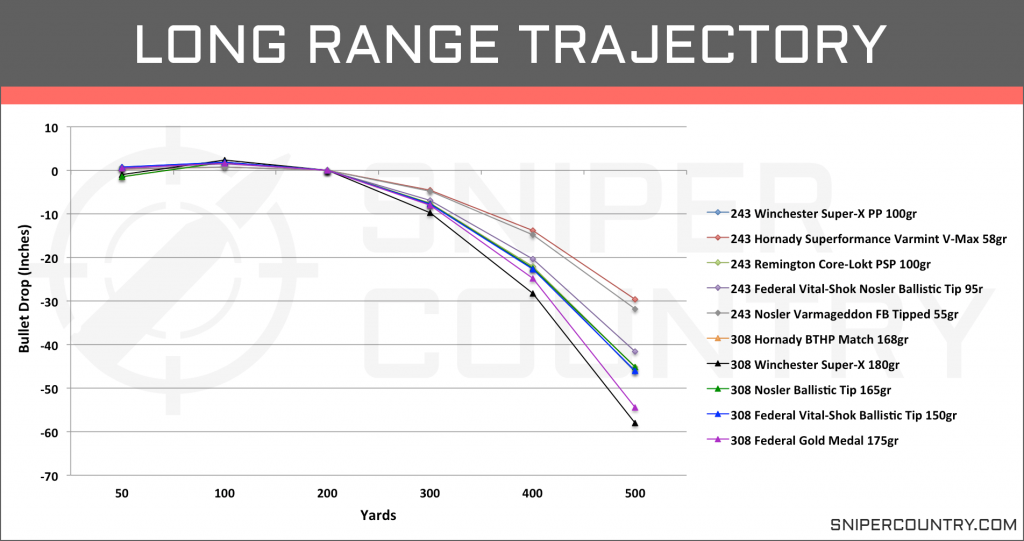
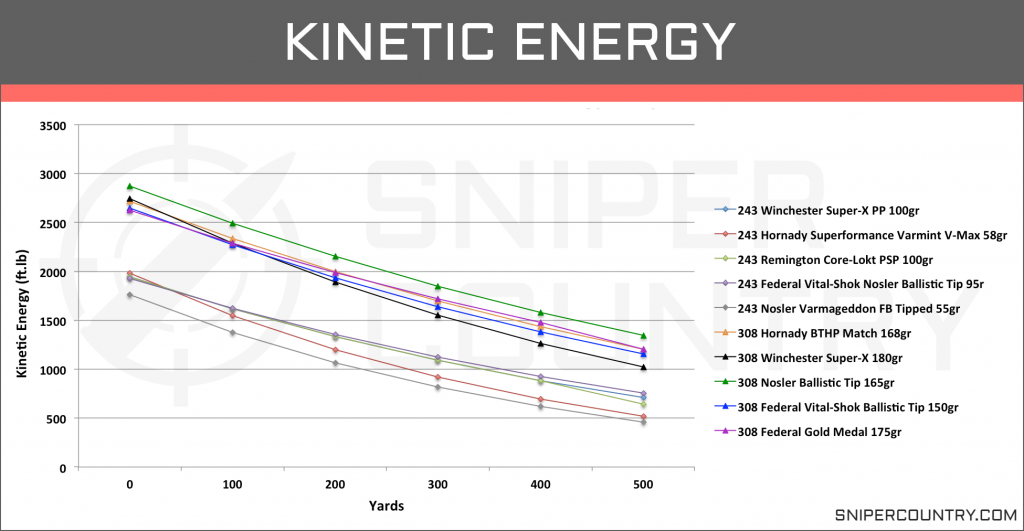
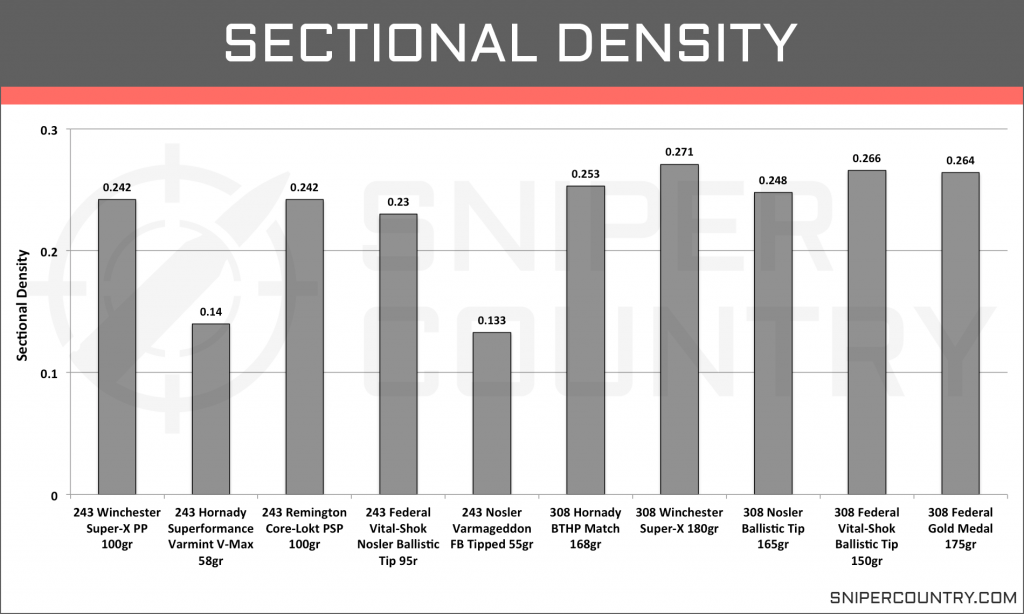
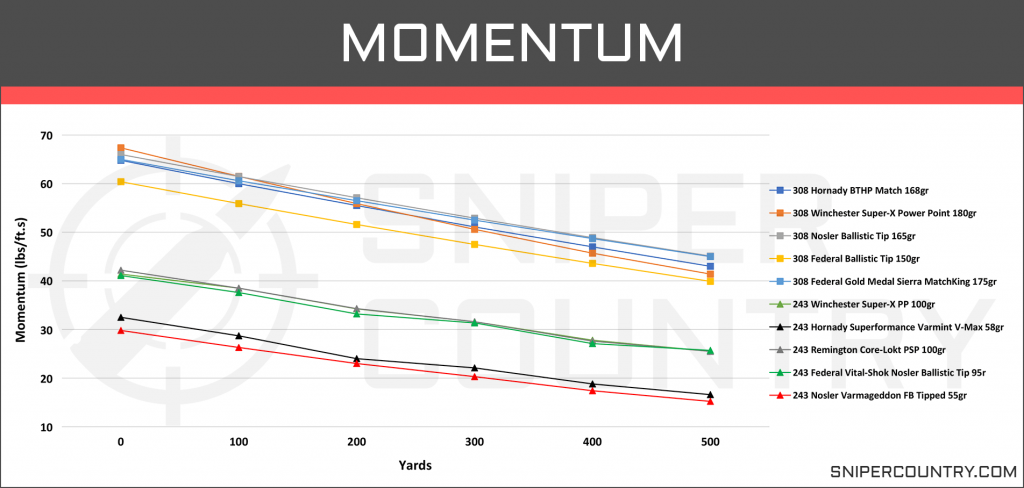

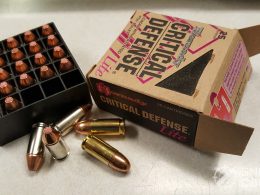
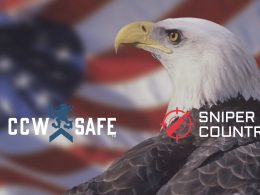
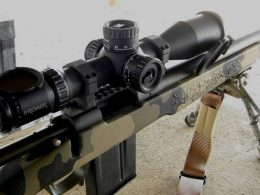
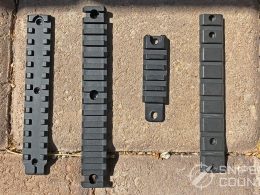
Your units for momentum are not properly displayed. [velocity] x [mass] as [feet/sec] x [lbs] should be represented as: pound foot per second (lb·ft/s).
Two pieces of data reduction that would be helpful/interesting: an opinion on velocity required for expansion; and bullet drop data with 100yd and 200yd zeros using some atmospheric and reticle height assumptions.
Thanks!
Very balanced comparison-honest and fair to two good cartridges
This is exactly the detail I was looking for. Very well written. Thanks.
Great details and more than enough infomation to assist on weapon selection. I am hoping to go Antelpoe huntng this summer and was trying to decide between my 308 or 243, now I have the answer, take them both.
I’ll look for more of your articles, I really enjoyed the read.
Thanks again.